County of Leiningen
The County of Leiningen consists on a group of counties (some of them with that were ruled with Imperial immediacy), which were ruled by the Leiningen family.
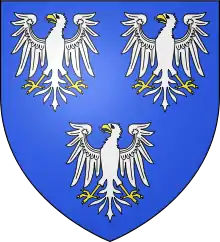
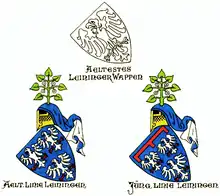
Most of these counties were annexed by the First French Republic in 1793, after French troops conquered the Left Bank of the Rhine during the War of the First Coalition. Several family branches subsequently received secularized abbeys as compensation, but shortly afterwards, these new counties were mediatized and the family lost its immediacy. Today, the only existing branch is that of the Princes of Leiningen.
Origins
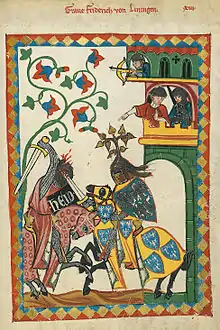
The first count of Leiningen about whom anything definite is known was a certain Emich II (d. before 1138). He (and perhaps his father Emich I) built Leiningen Castle, which is now known as "Old Leiningen Castle" (German: Burg Altleiningen), around 1100 to 1110. Nearby Höningen Abbey was built around 1120 as the family's burial place. The first reliable mention of the family dates back to 1128, when Emicho, Count of Leiningen testified to a document from Adalbert I of Saarbrücken, Archbishop of Mainz.[1]
This family became extinct in the male line when Count Frederick II died about 1214[2] or 1220. Frederick I's sister, Liutgarde, married Simon II, Count of Saarbrücken. One of Liutgarde's sons, also named Frederick, inherited the lands of the counts of Leiningen, and he took their arms and name as Frederick II (d. 1237).[3] Known as a Minnesinger, one of his songs was included in the Codex Manesse. Before 1212, he built himself a new castle called Hardenburg, about 10 kilometers south of Altleiningen. This was outside the county of Leiningen on the territory of Limburg Abbey, of which his uncle was the overlord (Vogt), which caused some trouble.
His eldest son, Simon (c. 1204–1234), married Gertrude, heiress of the County of Dagsburg, bringing that property into the family. They had no children and Simon's two brothers inherited the county of Leiningen together: Frederick III (d. 1287) also inherited Dagsburg and Emich IV (d. c. 1276) Landeck Castle; he founded the town of Landau, but the Landeck branch extinguished with his grandson in 1290. Frederick III, who disliked sharing Leiningen castle with his brother, had a new castle built in 1238–41 about 5 kilometres northeast of Leiningen, called Neuleiningen Castle ("New Leiningen"). Frederick III's son, Frederick IV (d. 1316), had two sons, who divided the county into Leiningen-Dagsburg and Leiningen-Hardenburg.
History
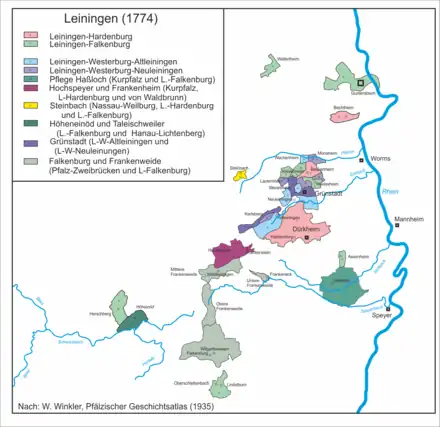

Having increased its possessions, the Leiningen family was divided around 1317 into two branches:
Leiningen-Westerburg
The elder of these, whose head was a landgrave, died out in 1467. Upon this event, its lands fell to a female, the last landgrave's sister Margaret, wife of Reinhard, Lord of Westerburg, and their descendants were known as the family of Leiningen-Westerburg. Later this family was divided into two branches, those of Leiningen-Westerburg-Alt-Leiningen and Leiningen-Westerburg-Neu-Leiningen, both of which are extinct today.
After the French Revolution, the Left Bank of the Rhine was conquered during the War of the First Coalition and annexed by France in 1793. The two counts of Alt- and Neu- Leiningen were arrested and jailed in Paris. They lost their territories. In 1803 they were compensated with secularized Ilbenstadt Abbey (at Niddatal) and Engelthal Abbey. The German mediatization brought an end to these short-lived counties in 1806, when their territories were divided between the Grand Duchy of Berg, the Grand Duchy of Hesse, Nassau-Weilburg and Nassau-Usingen. Ilbenstadt Abbey was sold by the House of Leiningen-Westerburg-Altleiningen in 1921, Engelthal Abbey by the heirs of the House of Leiningen-Westerburg-Neuleiningen in 1952.
Leiningen-Hardenburg
Meanwhile, the younger branch of the Leiningens, known as the family of Leiningen-Hardenburg, was flourishing. On 27 June 1560, this branch was divided into the lines of Leiningen-Dagsburg-Hardenburg, founded by Count Johann Philip (d. 1562), and Leiningen-Dagsburg-Heidesheim or Falkenburg, founded by Count Emicho (d. 1593).
In 1658 Leiningen-Dagsburg-Falkenburg divided into
- Leiningen-Dagsburg (extinct 1706)
- Leiningen-Heidesheim (extinct 1766)
- Leiningen-Guntersblum (extinct 1774)
The county of Leiningen-Dagsburg was inherited by Leiningen-Dagsburg-Hardenburg in 1774.
Leiningen-Guntersblum was divided between two further side branches:
- Leiningen-Dagsburg-Falkenburg-Guntersblum, which was deprived of its lands on the left bank of the Rhine by France, but in 1803 received Billigheim as a compensation, then called Leiningen-Billigheim. In 1845 they also acquired Neuburg Castle at Obrigheim. The branch became extinct in 1925.
- Leiningen-Heidesheim, which in 1803 received Neudenau and became known as Leiningen-Neudenau (extinct in 1910).
In 1779, the head of the Leiningen-Dagsburg-Hardenburg line was raised to the rank of a Prince of the Holy Roman Empire with the title of Prince of Leiningen. In 1801, this line was deprived of its lands on the left bank of the Rhine by France, but in 1803 it received Amorbach Abbey as an ample compensation for these losses. A few years later, the Principality of Leiningen at Amorbach was mediatized, and its territory is now included mainly in Baden, but partly in Bavaria and in Hesse. Amorbach Abbey is still today the family seat of the Prince of Leiningen.
Since 1991, the head of the princely line has been Prince Andreas (b. 1955).[4] His eldest brother, Prince Karl Emich was excluded from succession after he married morganatically.
Rulers
Partitions of Leiningen under Leiningen family
| County of Leiningen (1093-1316) |
Lordships of Runkel and Westerburg (until 1470) | |||||||||
| County of Leiningen- Dagsburg (1st creation) (1316-1470) | ||||||||||
| County of Leiningen- Richeling (1st creation) (1344-1507) |
County of Leiningen- Hardenburg (1316-1779) | |||||||||
| County of Leiningen-Westerburg (1470-1597) | ||||||||||
| Annexed to Daun-Oberstein and Hohenfels (from 1507) |
||||||||||
| County of Leiningen-Dagsburg (-Falkenburg; 2nd creation) (1541-1806) | ||||||||||
| County of Leiningen-Leiningen (1547-1656) |
||||||||||
| County of Leiningen- Schaumburg (1547-1708) | ||||||||||
| County of Leiningen- Richeling (2nd creation) (1622-1705) | ||||||||||
| County of Leiningen- Broich- Oberstein (1657-1709/22) |
County of Leiningen- Oberbronn (1622-1724) | |||||||||
| County of Leiningen- Neuleiningen (1695-1793) | ||||||||||
| County of Leiningen- Altleiningen (1695-1793) | ||||||||||
| County of Leiningen- Guntersblum (1657-1774) (1787-1806) | ||||||||||
| Raised to: Principality of Leiningen (1779-1806) |
||||||||||
| Mediatised to the Grand Duchy of Baden (from 1806) |
Mediatised to the Grand Duchy of Hesse (from 1806) |
Mediatised to the Grand Duchy of Baden (from 1806) |
Annexed to France (1793-1806) Mediatised to the Grand Duchies of Berg and Hesse and the Nassau Principalities of Weilburg and Usingen (from 1806) | |||||||
Table of rulers
- The House of Leiningen challenged at some times the German custom of male-originated surname. The original male line of the family died in 1214, and therefore had to rely on female succession and inheritance to preserve the surname. The post-1214 House of Leiningen (or agnatically House of Saarbrücken, as the family who ruled in the County of Saarbrücken) is cognatic, descendant of Liutgard, sister of the last count, Frederick I. The same applies to the line of Leiningen-Westerburg, originally called Runkel or Runkel-Westerburg: the inheritance of countess Margaret (d.1470) caused the change of name to Leiningen, and therefore included in the group of rulers of the family.
- The numberings are sometimes confusing: names like Emicho or Frederick are counted in order, independently of the land they ruled; however, other later rulers of the same name (like John Louis) are not numbered for having ruled different lands. To the sake of coherence, the list below goes for the former option.
| Ruler | Born | Reign | Death | Ruling part | Consort | Notes | |
|---|---|---|---|---|---|---|---|
| Emicho I | c.1054? | 1093-1117/38 | 1117 or 1138 | County of Leiningen | Alberade four children | Son of Emicho of Flonheim. Possibly the founder of the family and the county. | |
| Emicho II | ? | 1138-1189 | 1189 | County of Leiningen | Elisabeth (d.1179) three children | ||
| Frederick I | ? | 1189-1193 | 28 April 1193 | County of Leiningen | Unknown at least two children |
||
| Emicho III | ? | 1193-1208 | 1208 | County of Leiningen | Unknown | Left no heirs and was succeeded by his nephew. | |
| Frederick II | ? | 1189-1217/20 | 10 March 1217 or 1220 | County of Leiningen | Ita/Gertrude of Habsburg four children |
Nephew of Emicho III. After Frederick I's death with no offspring, the Leiningen lands were inherited by his namesake nephew, son of his sister Liutgard. | |
| Frederick III |  | c.1190 | 1217/20-1237 | 1237 | County of Leiningen | Agnes of Eberstein (1185-March 1263) two children Agnes of Zollern (d.10 March 1263) six children |
Designated heir by his maternal uncle, he came (agnatically) from the House of Saarbrücken, but adopted his mother's surname, Leiningen. He was a Minnesinger (or troubadour). He also built the Hardenburg Castle. |
| Frederick IV | c.1210 | 1237-1287 | 1287 | County of Leiningen | Adelaide of Kyburg (1220-aft.1258) c.1245 one child |
Children of Frederick II, divided the land. Frederick III inherited from his elder brother Simon (that predeceased his father) the County of Dagsburg. Simon had inherited it from his wife, the trouvère Gertrude of Dagsburg. Emicho IV established his rule at the region of Landau. | |
| Emicho IV | c.1215 | 1237-1281 | 1281 | County of Leiningen (at Landau) | Elisabeth d'Aspremont (1227-1264) 1235 four children | ||
| Emicho V | ? | 1281-1289 | 1289 | County of Leiningen (at Landau) | Catherine of Ochsenstein (d.1313) one child | After his death, the feud of Landau returned to the main line. | |
| Landau reabsorbed in Leiningen | |||||||
| Frederick V | 1250 | 1287-1316 | 1316 | County of Leiningen | Matilda c.1265 no children Johanna of Sponheim-Kreuznach (1246-1282) Before 1268 six children Jeanne d'Aspremont (d.1321) 1282 four children | ||
| Frederick VI | 1269 | 1316-1327 | 1327 | County of Leiningen-Dagsburg | Sophia of Freiburg (1274-29 March 1335) 7 July 1286 Strasbourg two children |
Children of Frederick V, divided the land. | |
| Godfrey I | 1304 | 1316-1344 | 1344 | County of Leiningen-Hardenburg | Agnes of Ochsenstein (d.bef.17 February 1321) 30 March 1313 one child Matilda of Salm (d.1341) 17 February 1321 three children | ||
| Frederick VII | 1294 | 1327-1342 | 1342 | County of Leiningen-Dagsburg | Judith of Isenburg-Limburg (d. 1335) seven children | ||
| Frederick VIII | ? | 1342-1378 | 1378 | County of Leiningen-Dagsburg | Marie of Châtillon 1353 one child |
Children of Frederick VII, ruled jointly. | |
| Frederick IX | 1320 | 1342-1397 | 1397 | County of Leiningen-Dagsburg | Catherine de Grandpré no children Yolande of Julich-Bergheim (d.1363) 1265 six children | ||
| Regency (1344-1354) | Children of Godfried I, divided the land. | ||||||
| Emicho VI | c.1340 | 1344-1381 | 17 February 1381 | County of Leiningen-Hardenburg | Liutgard of Falkenstein-Münzenberg c.1345 one child Margaret of Habsburg-Kyburg 1362 eight children | ||
| Fritzman [Frederick] | ? | 1344-1366 | 1366 | County of Leiningen-Richeling | Johanna of Forbach 16 October 1321 two children | ||
| Godfrey II | c.1325? | 1366-1380 | 1380 | County of Leiningen-Richeling | Margaret of Baden (d.c.1380) 10 November 1363 three children | ||
| John | c.1365 | 1380-1445 | c.1445 | County of Leiningen-Richeling | Elisabeth of Lützelstein (d.c.1435) six children | ||
| Emicho VII | 1366 | 1381-1452 | 1452 | County of Leiningen-Hardenburg | Clara of Finstingen-Brackenkopf (d.1409) 1383 no children Beatrice of Baden (24 June 1400 – 1452) 11 July 1411 ten children | ||
| Frederick X | 1269 | 1397-1434 | 1434 | County of Leiningen-Dagsburg | Margaret of Baden-Hachberg (d.1410) 1405 six children | ||
| Hesso |  | c.1405 | 1435-1467 | 8 March 1467 | County of Leiningen-Dagsburg | Elisabeth of Bavaria (c. 1406–5 March 1468) 1440 Worms no children | Left no heirs, and was succeeded by his sister. |
| Rudolph | c.1420? | 1445-1475 | 1475 | County of Leiningen-Richeling | Agnes of Zweibrücken-Bich (d.February 1454) 15 July 1435 nine children | ||
| Emicho VIII | 1452-1495 | 30 March 1495 | County of Leiningen-Hardenburg | Anna of Elter (d.aft.1500) Bef. 25 January 1466 eight children Barbara of Tengen-Nellenburg no children | In 1492 requested to the Pope to raise the parish church in Bad Dürkheim to the status of a collegiate church.[5] | ||
| Margaret | c.1405 | 1467-1470 | 1470 | County of Leiningen-Dagsburg | Reinhard I, Count of Westerburg (13 January 1388 – 22 December 1449) 24 August 1423 two children | Sister of Hesso, received the majority of his inheritance, and that was what made possible for her grandson and heir, Reinhard of Runkel, to adopt her surname after her death, forming the Leiningen-Westerburg branch. | |
| Dagsburg annexed to Runkel-Westerburg and absorbed in Hardenberg before 1540 | |||||||
| Reinhard I | 1453 | 1470-1522 | February 1522 | County of Leiningen-Westerburg | Anna of Eppenstein-Königstein (d.9 April 1483) 5 February 1456 three children Zymeria of Sayn (13 May 1469 – 2 June 1499) 12 August 1485 five children | Grandson of Margaret of Dagsburg. Inherited the county and the surname from her. Probably lost Dagsburg for Hardenburg, but he had other lands near Westerburg. | |
| Hahneman [Herman] | 1436 | 1475-1507 | 1507 | County of Leiningen-Richeling | Adelaide of Zirk (d.1508) Bef.1457 two children | ||
| Richeling inherited by Daun-Oberstein and Hohenfels | |||||||
| Emicho IX |  | c.1470 | 1495-1535 | 18 February 1535 | County of Leiningen-Hardenburg | Agnes of Eppstein-Münzenberg (d.28 July 1533) 1470 thirteen children | |
| Philip (I) | 1483 | 1522-1523 | 1523 | County of Leiningen-Westerburg | Unmarried | First son of Reinhard. He is usually not counted. Left no heirs. | |
| Cuno | 27 September 1487 | 1523-1547 | 23 November 1547 | County of Leiningen-Westerburg | Maria of Stolberg-Wernigerode (8 December 1507 – 6 January 1571) 1523 ten children |
Brother and sister of Philip, ruled jointly. Cuno was severely in debt to his sister, and gave her part of the county for her to rule in her own right. Eva proved to be a popular ruler: she founded a hospital in Grünstadt and became a popular symbol in the Palatinate. | |
| Eva | 1481 | 1523-1543 | 23 February 1543 | County of Leiningen-Westerburg | Unmarried | ||
| Emicho X | 1498 | 1535-1541 | 10 January 1541 | County of Leiningen-Hardenburg | Catherine of Nassau-Saarbrücken (11 November 1517 – 1 January 1553) 17 July 1537 three children | ||
| Regency (1541-1553) | Children of Emicho X, ruled under regency, and then divided the land. It's implied that sometime between 1470 and 1540, Dagsburg was acquired by Waldeck-Hardenburg. | ||||||
| John Philip I | 25 December 1539 | 1541-1562 | 8 September 1562 | County of Leiningen-Hardenburg | Anna of Mansfeld-Eisleben (d.6 June 1621) 15 December 1560 Mansfeld one child | ||
| Emicho XI | 15 December 1540 | 1541-1593 | 13 March 1593 | County of Leiningen-Dagsburg (-Falkenburg) | Ursula of Fleckenstein-Dagstuhl (1553-24 October 1595) 18 February 1577 Hardenburg two children | ||
| Philip I (II) | 10 November 1527 | 1547-1597 | 17 September 1597 | County of Leiningen-Leiningen | Amalia of Zweibrücken-Lichtenberg (1537-11 September 1577) 22 November 1551 Heidelberg six children Amalia of Daun-Falkenstein (26 September 1547 – 25 October 1608) 16 February 1578 six children |
Children of Cuno, divided the land. | |
| Reinhard II | 19 November 1530 | 1547-1584 | 17 September 1584 | County of Leiningen-Westerburg | Ottilia of Manderscheid-Blankenheim-Keil (30 July 1536 – 9 August 1597) 14 July 1561 eight children | ||
| George I | 23 April 1533 | 1547-1586 | 9 April 1586 | County of Leiningen-Schaumburg | Margaret of Isenburg-Birstein (14 December 1542 – 8 August 1613) 24 May 1570 Büdingen five children | ||
| Regency (1562-1576) | Published in 1580 the Book of Confessions[6] | ||||||
| Emicho XII | 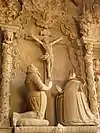 | 4 November 1562 | 1562-1607 | 24 November 1607 | County of Leiningen-Hardenburg | Maria Elisabeth of Palatinate-Zweibrücken (4 October 1561 – 28 February 1629) 7 November 1585 Hardenburg six children | |
| Albert Philip | 1567 | 1584-1597 | 1597 | County of Leiningen-Westerburg | Unmarried | Children of Reinhard II, ruled jointly. | |
| John Louis (I) | 1572 | 1597 | County of Leiningen-Westerburg | ||||
| Westerburg annexed to Schaumburg | |||||||
| Reinhard III | .jpg.webp) | 24 October 1574 | 1586-1655 | 14 October 1655 | County of Leiningen-Schaumburg | Anna of Solms-Lich (2 November 1575 – 1634) 1 January 1615 Lich three children |
Children of George I, ruled jointly. |
| Christoph | 30 September 1575 | 1586-1635 | 1635 | County of Leiningen-Schaumburg | Anna Maria Ungnad (29 September 1573 – 1606) 25 August 1601 one child Philippa Catherine of Wied (1595-1647) 1611 twelve children | ||
| John Louis (II) | 8 May 1579 | 1593-1625 | 19 June 1625 | County of Leiningen-Dagsburg (-Falkenburg) | Maria Barbara of Sulz (13 December 1588 – 1 March 1625) 1 June 1611 five children |
Children of Emicho XI, ruled jointly. | |
| Philip George | 26 July 1582 | 1593-1627 | 6 February 1627 | County of Leiningen-Dagsburg (-Falkenburg) | Anna of Erbach (27 April 1582 – 30 July 1650) 4 July 1614 Fürstenau five children | ||
| Louis | 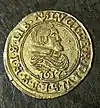 | 10 August 1557 | 1597-1622 | 22 August 1622 | County of Leiningen-Leiningen | Bernardine of Lippe 1578 nine children | |
| John Philip II | 26 April 1588 | 1607-1643 | 25 May 1643 | County of Leiningen-Hardenburg | Elisabeth of Leiningen-Dagsburg-Falkenburg (16 May 1586 – 25 October 1623) 1 January 1620 Hardenburg three children Anna Juliana of Salm-Kyrburg-Mörchingen (1584-12 November 1640) 23 February 1626 one child Anna Elisabeth of Oettingen-Oettingen (3 November 1603 – 3 June 1673) 11 June 1642 no children |
Children of Emicho XII, ruled jointly. | |
| Frederick XI | 8 February 1593 | 1607-1631 | 29 April 1631 | County of Leiningen-Hardenburg | Maria Elisabeth of Nassau-Saarbrücken (21 August 1602 – 9 December 1626) 22 August 1624 Saarbrücken no children Anna of Nassau-Weilburg (6 January 1597 – 7 January 1645) 18 (28) November 1628 Ottweiler six children | ||
| John Casimir | 1 February 1587 | 1622-1635 | 20/30 September 1635 | County of Leiningen-Leiningen | Martha of Hohenlohe-Langenburg (29 April 1575 – 19 December 1638) 23 January 1617 Langenburg no children |
Children of Louis, divided the land. John Casimir left no heirs, and after his death his share of the inheritance was split between the other two. | |
| Philip II (III) | 5 January 1591 | 1622-1668 | 9 February 1668 | County of Leiningen-Richeling | Agatha Catherine Schenk of Limpurg (30 July 1595 – 30 January 1664) 20 August 1618 two children | ||
| Louis Emicho | 14 August 1595 | 1622-1635 | 1 January 1635 | County of Leiningen-Oberbronn | Esther of Eberstein (11 April 1603 – 10 October 1682) 21 August 1624 five children | ||
| Leiningen-Leiningen annexed to Richeling and Oberbronn | |||||||
| Emicho XIII | 12 June 1612 | 1627-1657 | 1 March 1657 | County of Leiningen-Dagsburg (-Falkenburg) | Christiana of Solms-Laubach (23 September 1607 – 29 November 1638) 24 May 1632 Laubach two children Dorothea of Waldeck-Wildungen (225 February 1617-c.1670) 24 May 1632 Laubach seven children | Son of John Louis. | |
| John Louis (III) | 1625 | 1635-1665 | 18 April 1665 | County of Leiningen-Oberbronn | Sybilla Christina of Wied (1 April 1631 – 11 October 1707) 1651 seven children | ||
| Frederick Emicho | 9 February 1621 | 1643-1698 | 26 July 1698 | County of Leiningen-Hardenburg | Sybilla of Waldeck-Wildungen (25 March 1619 – 30 September 1678) 15 June 1644 Hardenburg nine children |
Children of John Philip II, ruled jointly. | |
| John Philip III | 19 February 1622 | 1643-1666 | 19 February 1666 | County of Leiningen-Hardenburg | Agnes of Waldeck-Wildungen (2 February 1617 – 29 November 1651) 5 February 1551 Waldeck one child Elisabeth Charlotte of Solms-Sonnenwalde (1621-17 January 1660) 1658 one child | ||
| George William (I) | 10 February 1619 | 1655-1695 | 22 November 1695 | County of Leiningen-Schaumburg | Sophia Elisabeth of Lippe-Detmold (31 March 1626 – 23 August 1688) 7 May 1644 Schwalenberg nineteen children | ||
| George William (II) | 8 March 1632 | 1657-1672 | 19 July 1672 | County of Leiningen-Dagsburg (-Falkenburg) | Anna Elisabeth of Daun-Falkenstein (1 January 1636 – 4 June 1685) 24 March 1658 five children |
Children of Emicho XIII, divided the land. Emich Christian left no surviving sons. While Broich was reannexed to Dagsburg, Oberstein was inherited by his daughter. | |
| Emich Christian | 29 March 1642 | 1657/82-1702 | 27 April 1702 | County of Broich-Oberstein | Christiane Louise of Daun-Falkenstein (18 July 1640 – 27 April 1702) 17 July 1664 Falkenstein twelve children (bg) | ||
| John Louis I (IV) | 26 February 1643 | 1657-1687 | 2 March 1687 | County of Leiningen-Guntersblum | Amalia Sybilla of Daun-Falkenstein (27 June 1639-?) 22 August 1664 two children Sophia Sybilla, Countess of Leiningen-Oberbronn (14 July 1656 – 13 April 1724) 1678 two children | ||
| Broich reabsorbed by Dagsburg-Falkenstein | |||||||
| Esther Juliana | 1656 | 1665-1709 | 1709 | County of Leiningen-Oberbronn | Louis, Baron of Sinclair (d.1783) no children |
Daughters of John Louis, ruled jointly. Esther Juliana controlled 1/3 and Sophia Sibylla 2/3 of the county. The estate eventually passed to the children of Sophia Sibylla's first marriage, which meant an annexation to Leiningen-Guntersblum. | |
| Sophia Sibylla | 14 July 1656 | 1665-1724 | 13 April 1724 | County of Leiningen-Oberbronn | John Louis I, Count of Leiningen-Guntersblum (26 February 1643 – 2 March 1687) 1678 two children Frederick II, Landgrave of Hesse-Homburg 15 November 1691 Bad Homburg three children | ||
| Oberbronn annexed to Guntersblum | |||||||
| Louis Eberhard | 18 July 1624 | 1668-1688 | 14 November 1688 | County of Leiningen-Richeling | Charlotte of Nassau-Saarbrücken (1 December 1619 – 13 November 1687) 6/16 January 1650 Altleiningen seven children | ||
| John Charles August | 19 March 1662 | 1672-1698 | 13 November 1698 | County of Leiningen-Dagsburg (-Falkenburg) | Johanna Magdalene of Hanau-Lichtenberg 13 December 1685 Babenhausen seven children | ||
| John Louis II (V) | 29 July 1673 | 1687-1699 | 1699 | County of Leiningen-Guntersblum | Anna Ernestina of Vehlen-Megen (12 April 1650 – 23 February 1729) 1694 four children |
Children of John Louis I, ruled jointly. | |
| Emich Leopold | 6 November 1685 | 1687-1719 | 2 January 1719 | County of Leiningen-Guntersblum | Charlotte Amalia of Leiningen-Dagsburg-Falkenburg (1682-1729) 5 March 1709 six children | ||
| Philip Louis | 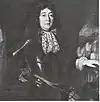 | 1652 | 1688-1705 | 16 August 1705 | County of Leiningen-Richeling | Louise Gabrielle de Rouse (d.24 December 1698) 26 December 1673 Paris five children Sidonia Theresa of Ibiswald (d.April 1720) 1699 no children | Left no heirs. His county was annexed to Leiningen-Schaumburg. |
| Richeling annexed to Schaumburg | |||||||
| John Anton | 15 January 1655 | 1695-1698 | 2 October 1698 | County of Leiningen-Schaumburg | Christina Louise of Sayn-Wittgenstein (1673-25 February 1745) 13 February 1692 two children |
Children of George William, ruled jointly. | |
| Henry Christian | 1 February 1665 | 1695-1702 | 2 February 1702 | County of Leiningen-Schaumburg | Albertina Elisabeth of Sayn-Wittgenstein (20 July 1661 – 26 November 1716) 20 July 1681 two children | ||
| Christoph Christian | 11 March 1656 | 1695-1728 | 17 May 1728 | County of Leiningen-Altleiningen | Juliana Elisabeth of Lippe-Biesterfeld (15 June 1656 – 29 April 1739) 6/8 June 1678 three children | ||
| George II |  | 2 March 1666 | 1695-1726 | 4 May 1726 | County of Leiningen-Neuleiningen | Anna Elisabeth Wilhelmina von Bentheim-Tecklenburg (1641-26 May 1696) 27 May 1684 no children Anna Magdalena of Bodenhausen (6 October 1660 – 6 September 1709) 1697 one child Margaretha Christiana Augusta of Gildevnlöw-Daneskiold-Laurwig (18 July 1694 – 8 July 1761) 2 (23) February 1711 Augustenburg nine children | |
| John Frederick | 18 March 1661 | 1698-1722 | 9 February 1722 | County of Leiningen-Hardenburg | Dorothea Friederike of Allefeld-Rixingen (16 December 1661 – 16 November 1698) September 1686 two children Catherine of Baden-Durlach (10 October 1677 – 11 August 1746) 19 June 1701 Karlsburg Castle six children | ||
| Christian Charles Reinhard |  | 7 July 1695 | 1698-1766 | 17 November 1766 | County of Leiningen-Dagsburg (-Falkenburg) (at Broich) | Catherine Polyxena of Solms-Rödelheim (30 January 1702 – 29 March 1765) 27 November 1726 Mettenheim six children |
Children of John Charles August. Christian Charles inherited Broich, and John William Louis the rest of Dagsburg-Falkenburg. It's possible that Falkenburg reverted to Hardenburg after John William's death. |
| John William Louis | 5 April 1697 | 1698-1742 | November 1742 | County of Leiningen-Dagsburg (-Falkenburg) | Sophia Eleonore of Leiningen-Guntersblum (1710-19 June 1768) 1730 two children | ||
| Dagsburg-Falkenburg (except Broich) annexed to Hardenburg | |||||||
| Elisabeth Dorothea | 11 June 1665 | 1702-1722 | 1722 | County of Broich-Oberstein (at Oberstein only) | Maurice Herman, Count of Limburg-Stirum 19 October 1692 six children | Inherited Oberstein, and may have passed it to her descendants. | |
| Oberstein inherited by Limburg-Stirum | |||||||
| Regency (1702-1707) | Son of John Anton, left no heirs. | ||||||
| George Frederick | 1693 | 1702-1708 | 1708 | County of Leiningen-Schaumburg | Unmarried | ||
| Schaumburg was divided between Altleiningen and Neuleiningen | |||||||
| John Francis | 22 May 1698 | 1719-1750 | 1750 | County of Leiningen-Guntersblum | Charlotte of Walderode (24 September 1703 – 1745) 6 July 1736 three children |
Cousins, ruled jointly. John Francis was a son of John Louis II, and Emich Louis was a son of Emich Leopold. | |
| Emich Louis | 22 December 1709 | 1719-1766 | 23 September 1766 | County of Leiningen-Guntersblum | Polyxena Wilhelmina of Leiningen-Dagsburg-Falkenburg (8 October 1730 – 21 March 1800) 27 March 1752 two children | ||
| Frederick Magnus | 27 March 1703 | 1722-1756 | 28 October 1756 | County of Leiningen-Hardenburg | Anna Christiana Eleonora of Wurmbrand-Stupach (13 March 1698 – 4 January 1763) 26 November 1723 five children |
Children of John Frederick, divided the land. | |
| Charles Louis | 16 February 1704 | 1722-1747 | 20 March 1747 | County of Leiningen-Hardenburg (at Bockenheim) | Caroline of Salm-Daun (7 January 1706 – 26 May 1786) 27 November 1726 three children | ||
| Bockenheim reabsorbed in Hardenburg | |||||||
| George Charles | 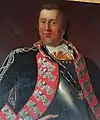 | 17 February 1717 | 1726-1787 | 19 March 1787 | County of Leiningen-Neuleiningen | Johanna Elisabeth Amalia of Isenburg-Philippseich (19 March 1720 – 29 December 1780) 7 May 1741 Philippseich eight children |
Children of George II, ruled jointly. |
| George Ernest | 3 May 1718 | 1726-1765 | 24 December 1765 | County of Leiningen-Neuleiningen | Maria Louise of Wieser (10 April 1710 – 7 May 1773) 1738 eight children | ||
| George Herman | 21 March or 1 April 1679 | 1728-1751 | 3 January or 4 February 1751 | County of Leiningen-Altleiningen | Augusta Wilhelmina Philippina of Schaumburg-Lippe (15 June 1693 – 29 April 1721) 26 February 1712 Detmold no children Charlotte Wilhelmina of Pappenheim (15 June 1693 – 29 April 1721) 24 December 1724 five children | ||
| Christian John | 31 August 1730 | 1751-1770 | 20 February 1770 | County of Leiningen-Altleiningen | Christiana Franziska Eleonora of Grumbach (10 August 1735 – 29 November 1809) 5 December 1754 eleven children | ||
| Charles Frederick William | 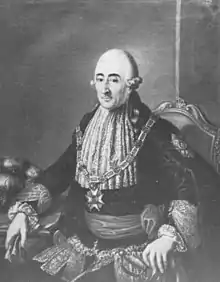 | 14 August 1724 | 1756-1806 | 9 January 1807 | County of Leiningen-Hardenburg (1756–79) Principality of Leiningen (1779-1806) | Christiane Wilhelmine of Solms-Rödelheim and Assenheim (24 April 1736 – 6 January 1803) 24 June 1749 four children | Elevated to Prince in 1779. In 1806, he was stripped of his functions as ruler of the principality, following the German mediatisation of 1806. From then on, he and his descendants kept only the title. |
| Leiningen mediatiased to the Grand Duchy of Baden | |||||||
| William Charles | 1737 | 1766-1774 1787-1806[7] | 1809 | County of Leiningen-Guntersblum (at Billigheim) | Eleonora of Bretzenheim (1770-1832) 21 November 1787 (annulled 1801) two children |
Children of John Francis, divided the land. They were both deposed in 1774, and Guntersblum was briefly annexed to Hardenburg. However, their possession were restored in 1787, to be definitely taken from them in 1806. | |
| Wenceslaus Joseph | 1738 | 1825 | County of Leiningen-Guntersblum (at Neudenau) | Maria Margaretha of Sickingen (1744-1795) 11 June 1772 no children Maria Victoria of Grünberg (d.1838) 24 October 1803 no children | |||
| Guntersblum annexed to Hardenberg | |||||||
| Maria Louise |  | 16 March 1729 | 1766-1806 | 11 March 1818 | County of Leiningen-Dagsburg (-Falkenburg) (at Broich) | Prince George William of Hesse-Darmstadt 16 March 1748 Heidesheim am Rhein nine children | Daughter of Christian Charles Reinhard, Maria Louise inherited her father's domains. In 1806, following the German mediatisation, Maria Louise lost her county. |
| Broich mediatiased to the Grand Duchy of Hesse | |||||||
| Christian Charles |  | 18 September 1757 | 1770-1793 | 1 December 1811 | County of Leiningen-Altleiningen | Unmarried[8] | In the aftermath of the French Revolution (1793), the county was annexed to France. |
| Altleiningen annexed to France (1793-1806); Mediatised to the Grand Duchies of Berg and Hesse, and the Nassau Principalities of Weilburg and Usingen (from 1806) | |||||||
| Charles Gustav |  | 28 June 1747 | 1787-1793 | 7 June 1798 | County of Leiningen-Neuleiningen | Unmarried[8] | Cousins, ruled jointly. Charles Gustav was a son of George Charles, and Charles Joseph was a son of George Ernest. In the aftermath of the French Revolution (1793), the county was annexed to France. |
| Charles Joseph | 13 August 1739 | 27 July 1797 | County of Leiningen-Neuleiningen | Maria Friederika Wilhelmina Elisabeth Schmittener (22 May 1753 – 29 April 1828)[9] 1782 six children | |||
| Altleiningen annexed to France (1793-1806); Mediatised to the Grand Duchies of Berg and Hesse, and the Nassau Principalities of Weilburg and Usingen (from 1806) | |||||||
Succession in the Principality of Leiningen
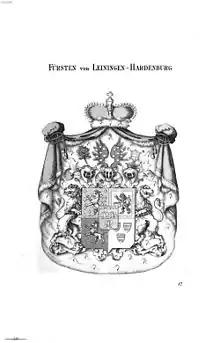
- Carl Friedrich Wilhelm, 1st Prince of Leiningen (1724–1807)
- Emich Carl, 2nd Prince of Leiningen (1763–1814)
- Carl, 3rd Prince of Leiningen (1804–1856)
- Ernst, 4th Prince of Leiningen (1830–1904)
- Emich, 5th Prince of Leiningen (1866–1939)
- Karl, 6th Prince of Leiningen (1898–1946)
- Emich, 7th Prince of Leiningen (1926–1991)
- Andreas, 8th Prince of Leiningen (born 1955)
- his heir-apparent, Ferdinand, Hereditary Prince of Leiningen (born 1982)
Succession in the County of Altleiningen
- Christian Karl, Count of Leiningen-Altleiningen (18 Sep 1757 – 1 Dec 1811)
- Friedrich I Ludwig Christian, Count of Leiningen-Altleiningen (2 Nov 1761 – 9 Aug 1839)
- Friedrich II Eduard, Count of Leiningen-Altleiningen (20 May 1806 – 5 Jun 1868)
- Friedrich III Wipprecht Franz, Count of Leiningen-Altleiningen (30 Dec 1852 – 7 Feb 1916), nephew
- Gustav Friedrich Oskar, Count of Leiningen-Altleiningen (8 Feb 1876 – 23 Jul 1929)[10]
Succession in the County of Neuleiningen
- Ferdinand Karl III, Count of Leiningen-Neuleiningen (8 Sep 1767 – 26 Nov 1813)
- August George Gustav, Count of Leiningen-Neuleiningen (19 Feb 1770 – 9 Oct 1849)
- Christian Franz Seraph Vincenz, Count of Leiningen-Neuleiningen (1810 – 1856)
- George Karl August, Count of Leiningen-Neuleiningen (27 Aug 1789 – 17 Mar 1865), cousin of the previous
- Wilhelm, Count of Leiningen-Neuleiningen (16 Feb 1824 – 29 Apr 1887) - Inherited by Altleiningen
Notes
- Toussaint 1982, S. 204.
- Toussaint 1982, S. 248.
- Franz Neumer: Ist Hochspeyer eine leiningische Gründung?, in Jahrbuch zur Geschichte von Stadt und Landkreis Kaiserslautern, Band 32/33, 1994/95, S. 17 (quoting Ruppersberg 1979 and Toussaint 1982).
- Genealogisches Handbuch des Adels (2004), Volume 133, p. 249, 251.
- Franz Haffner: Ist die Schloßkirche in Bad Dürkheim eine ehemalige Stiftskirche?, in: Pfälzer Heimat 18, 1967, S. 3 bzw. VatA, Rom/I, Reg. Suppl. 964, Bl. 38v.
- See Confessions of the Evangelical Lutheran Church , p. 16 and p. 764.
- Graf Wenzel Joseph von Leiningen-Heidesheim
- Runkel (Leiningen-Westerburg)
- Runkel/Leiningen-Westerburg
- Marek, Miroslav. "runkel/runkel3.html". genealogy.euweb.cz.
References
- Constantin von Wurzbach: Leiningen, das Haus, Genealogie. In: Biographisches Lexikon des Kaiserthums Oesterreich. 14. Theil. Kaiserlich-königliche Hof- und Staatsdruckerei, Wien 1865, S. 328 f.
- Detlev Schwennicke, Europaische Stammtafeln, New Series, Vol. XVII, Tafel 62. Vol. XXIX, Tafel 73. Vol. XXIX, Tafel 72.
- Europaische Stammtafeln, by Wilhelm Karl, Prinz zu Isenburg, Vol. IV, Tafel 32.
- Genealogisches Handbuch des Adels, Adelslexikon Band VII, Band 97 der Gesamtreihe, C. A. Starke Verlag, Limburg (Lahn) 1989, ISSN 0435-2408
- Heiberger, Hans (2000). Das Ende der Grafen zu Leiningen-Westerburg in ihrem Ursprungsland und dem Fortbestehen des Namens Leiningen-Westerburg in Österreich (in German). Grünstadt: K. Dinges. ISBN 3-9806596-1-5. OCLC 52944056.
- Gehrlein, Thomas (2010). Das Haus Leiningen 900 Jahre Gesamtgeschichte mit Stammfolgen (in German). Werl. ISBN 978-3-9811993-9-0. OCLC 688612934.
{{cite book}}: CS1 maint: location missing publisher (link)
Attribution
- This article incorporates text from a publication now in the public domain: Chisholm, Hugh, ed. (1911). "Leiningen". Encyclopædia Britannica. Vol. 16 (11th ed.). Cambridge University Press. p. 399. This work in turn cites:
- Brinckmeier (1890–1891). Genealogische Geschichte des Hauses Leiningen. Brunswick.
{{cite book}}: CS1 maint: location missing publisher (link)
- Brinckmeier (1890–1891). Genealogische Geschichte des Hauses Leiningen. Brunswick.
External links
- European Heraldry page Archived 2023-02-14 at the Wayback Machine
- Website of the Prince of Leiningen
- Genealogy - Grafen von Leiningen
- Leiningen
- Our Royal Titled Noble and Commoner Ancestors - Leiningen and Westerburg (click on the links to travel between members)